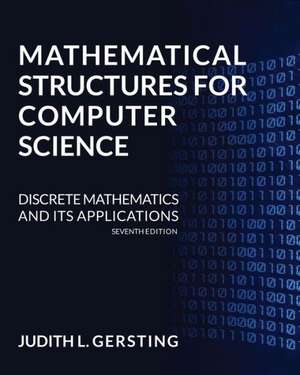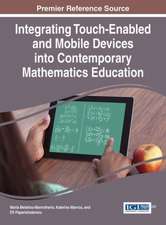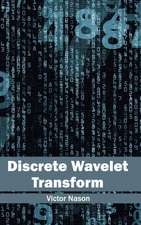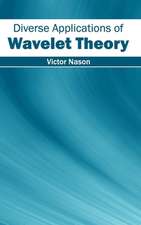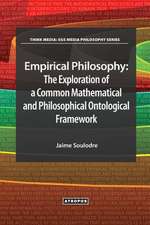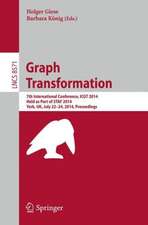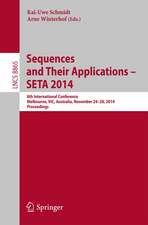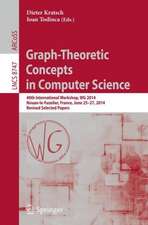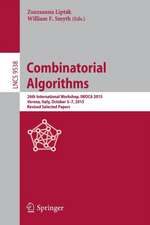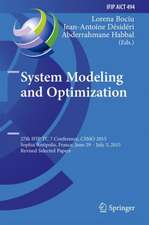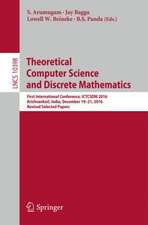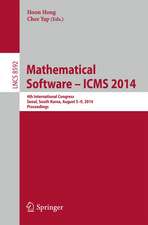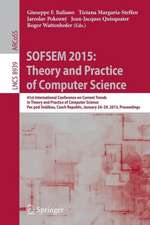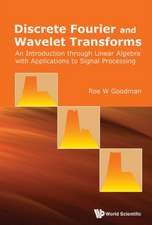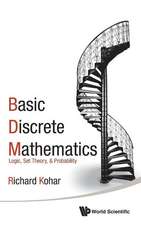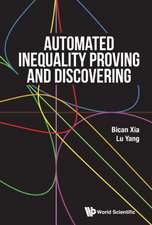Mathematical Structures for Computer Science
Autor Judith L. Gerstingen Limba Engleză Hardback – 14 sep 2015
Preț: 576.80 lei
Preț vechi: 869.61 lei
-34% Nou
110.37€ • 115.77$ • 91.88£
Carte disponibilă
Livrare economică 11-25 martie
Specificații
ISBN-10: 1429215100
Pagini: 816
Ilustrații: colour line drawings, colour tables, figures
Dimensiuni: 210 x 262 x 38 mm
Greutate: 1.86 kg
Ediția:Revizuită
Editura: W. H. Freeman
Colecția W. H. Freeman
Locul publicării:New York, United States
Cuprins
1. Formal Logic
1.1 Statements, Symbolic Representation, and Tautologies
Connectives and Truth Values
Tautologies
Logical Connectives in the Real World
An Algorithm
Special Interest Page – Can "And" Ever Be "Or"?
Section 1.1 Review
Exercises 1.1
1.2 Propositional Logic
Valid Arguments
Derivation Rules for Propositional Logic
Deduction Method and Other Rules
Verbal Arguments
Section 1.2 Review
Exercises 1.2
1.3 Quantifiers, Predicates, and Validity
Quantifiers and Predicates
Translation
Validity
Section 1.3 Review
Exercises 1.3
1.4 Predicate Logic
Derivation Rules for Predicate Logic
Universal Instantiation
Existential Instantiation
Universal Generalization
Existential Generalization
More Work with Rules
Verbal Arguments
Conclusion
Section 1.4 Review
Exercises 1.4
1.5 Logic Programming
Prolog
Horn Clauses and Resolution
Recursion
Expert Systems
Section 1.5 Review
Exercises 1.5
1.6 Proof of Correctness
Assertions
Assignment Rule
Conditional Rule
Section 1.6 Review
Exercises 1.6
Chapter 1 Review
On the Computer
2. Proofs, Induction, and Number Theory
2.1 Proof Techniques
Theorems and Informal Proofs
To Prove or Not to Prove
Exhaustive Proof
Direct Proof
Contraposition
Contradiction
Serendipity
Common Definitions
Section 2.1 Review
Exercises 2.1
2.2 Induction
First Principle of Induction
Proofs by Mathematical Induction
Second Principle of Induction
Section 2.2 Review
Exercises 2.2
2.3 More on Proof of Correctness
Loop Rule
Euclidean Algorithm
Special Interest Page – Making Safer Software
Section 2.3 Review
Exercises 2.3
2.4 Number Theory
The Fundamental Theorem of Arithmetic
More on Prime Numbers
Euler Phi Function
Section 2.4 Review
Exercises 2.4
Chapter 2 Review
On the Computer
3. Recursion, Recurrence Relations, and Analysis of Algorithms
3.1 Recursive Definitions
Recursively Defined Sequences
Recursively Defined Sets
Recursively Defined Operations
Recursively Defined Algorithms
Section 3.1 Review
Exercises 3.1
3.2 Recurrence Relations
Linear First-Order Recurrence Relations
Expand, Guess, and Verify
A Solution Formula
Linear Second-Order Recurrence Relations
Divide-and-Conquer Recurrence Relations
Section 3.2 Review
Exercises 3.2
3.3 Analysis of Algorithms
The General Idea
Analysis Using Recurrence Relations
Upper Bound (Euclidean Algorithm)
Special Interest Page - Of Trees … and Pancakes
Section 3.3 Review
Exercises 3.3
Chapter 3 Review
On the Computer
4. Sets, Combinatorics, and Probability
4.1 Sets
Notation
Relationships between Sets
Sets of Sets
Binary and Unary Operations
Operations on Sets
Set Identities
Countable and Uncountable Sets
Section 4.1 Review
Exercises 4.1
4.2 Counting
Multiplication Principle
Addition Principle
Using the Principles Together
Decision Trees
Section 4.2 Review
Exercises 4.2
4.3 Principle of Inclusion and Exclusion; Pigeonhole Principle
Principle of Inclusion and Exclusion
Pigeonhole Principle
Section 4.3 Review
Exercises 4.3
4.4 Permutations and Combinations
Permutations
Combinations
Eliminating Duplicates
Permutations and Combinations with Repetitions
Generating Permutations and Combinations
Special Interest Page – Archimedes and the Stomachion
Section 4.4 Review
Exercises 4.4
4.5 Binomial Theorem
Pascal's Triangle
Binomial Theorem and Its Proof
Applying the Binomial Theorem
Section 4.5 Review
Exercises 4.5
4.6 Probability
Introduction to Finite Probability
Probability Distributions
Conditional Probability
Bayes' Theorem
Expected Value
Binomial Distribution
Average Case Analysis of Algorithms
Section 4.5 Review
Exercises 4.6
Chapter 4 Review
On the Computer
5. Relations, Functions, and Matrices
5.1 Relations
Binary Relations
Properties of Relations
Closures of Relations
Partial Orderings
Equivalence Relations
Section 5.1 Review
Exercises 5.1
5.2 Topological Sorting
Section 5.2 Review
Exercises 5.2
5.3 Relations and Databases
Entity-Relationship Model
Relational Model
Operations on Relations
Null Values and Three-Valued Logic
Database Integrity
Section 5.3 Review
Exercises 5.3
5.4 Functions
Definition
Properties of Functions
Onto Functions
One-to-One Functions
Bijections
Composition of Functions
Inverse Functions
Permutation Functions
How Many Functions
Equivalent Sets
Section 5.4 Review
Exercises 5.4
5.5 Order of Magnitude
Function Growth
More on Analysis of Algorithms
The Master Theorem
Proof of the Master Theorem
Section 5.5 Review
Exercises 5.5
5.6 The Mighty Mod Function
Hashing
Computer Security
Cryptography
Hashing for Password Encryption
Miscellaneous Applications
Identification Codes
Generating and Decomposing Integers
Modular Arithmetic Designs
Section 5.6 Review
Exercises 5.6
5.7 Matrices
Terminology
Matrix Operations
Gaussian Elimination
Boolean Matrices
Special Interest Page - Solve Millions of Equations, Faster than Gauss
Section 5.7 Review
Exercises 5.7
Chapter 5 Review
On the Computer
6. Graphs and Trees
6.1 Graphs and their Representations
Definitions of a Graph
Applications of Graphs
Graph Terminology
Isomorphic Graphs
Planar Graphs
Computer Representation of Graphs
Adjacency Matrix
Adjacency List
Special Interest Page - Isomorphic Protein Graphs
Section 6.1 Review
Exercises 6.1
6.2 Trees and their Representations
Tree Terminology
Applications of Trees
Binary Tree Representation
Tree Traversal Algorithms
Results About Trees
Section 6.2 Review
Exercises 6.2
6.3 Decision Trees
Searching
Lower Bounds on Searching
Binary Tree Search
Sorting
Section 6.3 Review
Exercises 6.3
6.4 Huffman Codes
Problem and Trial Solution
Huffman Encoding Algorithm
Justification
Application of Huffman Codes
Section 6.4 Review
Exercises 6.4
Chapter 6 Review
On the Computer
7. Graph Algorithms
7.1 Directed Graphs and Binary Relations; Warshall's Algorithm
Directed Graphs and Binary Relations
Reachability
Warshall's Algorithm
Section 7.1 Review
Exercises 7.1
7.2 Euler Path and Hamiltonian Circuit
Euler Path Problem
Hamiltonian Circuit Problem
Section 7.2 Review
Exercises 7.2
7.3 Shortest Path and Minimal Spanning Tree
Shortest-Path Problem
Minimal Spanning Tree Problem
Special Interest Page - Pathfinding
Section 7.3 Review
Exercises 7.3
7.4 Traversal Algorithms
Depth-First Search
Breadth-First Search
Analysis
Applications
Section 7.4 Review
Exercises 7.4
7.5 Articulation Points and Computer Networks
The Problem Statement
The Idea Behind the Algorithm
The Algorithm Itself
Section 7.5 Review
Exercises 7.5
Chapter 7 Review
On the Computer
8. Boolean Algebra and Computer Logic
8.1 Boolean Algebra Structure
Models or Abstractions
Definition and Properties
Isomorphic Boolean Algebras
What is Isomorphism?
Isomorphism as Applied to Boolean Algebra
Section 8.1 Review
Exercises 8.1
8.2 Logic Networks
Combinational Networks
Basic Logic Elements
Boolean Expressions
Truth Functions
Networks and Expressions
Canonical Form
Minimization
Programmable Logic Devices
A Useful Network
Other Logic Elements
Constructing Truth Functions
Special Interest Page - Pruning Chips and Programs
Section 8.2 Review
Exercises 8.2
8.3 Minimization
Minimization Process
Karnaugh Map
Maps for Three and Four Variables
Using the Karnaugh Map
Quine-McCluskey Procedure
Section 8.3 Review
Exercises 8.3
Chapter 8 Review
On the Computer
9. Modeling Arithmetic, Computation, and Languages
9.1 Algebraic Structures
Definitions and Examples
Basic Results about Groups
Subgroups
Isomorphic Groups
Section 9.1 Review
Exercises 9.1
9.2 Coding Theory
Introduction
Background: Homomorphisms and Cosets
Generating Group Codes
Decoding Group Codes
Section 9.2 Review
Exercises 9.2
9.3 Finite-State Machines
Definition
Examples of Finite-State Machines
Recognition
Regular Sets and Kleene's Theorem
Machine Minimization
Unreachable States
Minimization Procedure
Sequential Networks and Finite-State Machines
Special Interest Page – FSMs Behind the Game
Section 9.3 Review
Exercises 9.3
9.4 Turing Machines
Definition
Turing Machines as Set Recognizers
Turing Machines as Function Computers
Church-Turing Thesis
Decision Problems and Uncomputability
Examples of Decision Problems
Halting Problem
Computational Complexity
Section 9.4 Review
Exercises 9.4
9.5 Formal Languages
Classes of Grammars
Formal Languages and Computational Devices
Context-Free Grammars
Section 9.5 Review
Exercises 9.5
Chapter 9 Review
On the Computer
Appendix A Derivation Rules for Propositional and Predicate Logic
Appendix B Summation and Product Notation
Appendix C The Logarithm Function
Appendix D The Binary Number System
Answers to Practice Problems
Answers to Odd-Numbered Exercises
Answers to Self-Tests
Index
Notă biografică
Caracteristici
Introduces students to computer mathematics without overwhelming them
Balances clear presentation of the concepts with applications relevant to computer science majors
First Discrete Math text revised based on the ACM/IEEE standards for the discrete structures core
